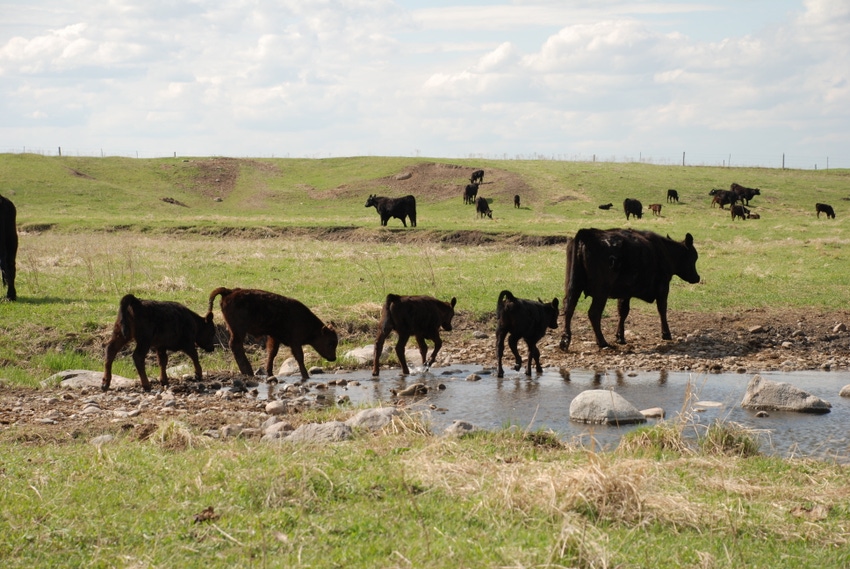More cow-calf producers could increase revenue by implanting calves pre-weaning, research shows.
March 2, 2014

“Implanting nursing calves with a growth stimulant is one of the most economically justifiable practices available in the beef industry,” says Lawton Stewart, University of Georgia Extension beef cattle specialist.
Stewart points to research trials where daily gain from birth to weaning increases by 4%-6% in nursing beef calves that receive a single implant. Other research suggests the response can be even higher. Stewart also notes that growth response is about 20% greater in heifers than steers.
For the sake of illustration, assume that implanting calves on the cow increases gain by 5%. Figure 15-30 lbs. more weaning weight. In today’s market (basis $1.80) that’s worth $27-$54/head. The cost of the implant and labor is routinely less than $2/head.
Yet, only a minority of cow-calf producers utilizes implants in their pre-weaned calves. In fact, according to the most recent National Animal Health Monitoring Service “Beef” study published for 2007-2008, only 11.9% of operations surveyed had implanted any calves prior to, or at, weaning during the previous year. Even for producers with 200 cows or more, only 31.1% reported implanting at least some calves.
If Superior Auction data is any indication, implant use by cow-calf producers continues to trend lower over time.
Interested in more beef news? Subscribe NOW to Cow-Calf Weekly for the latest industry research and news straight your inbox.
In 1995, 64.3% of the lots sold through Superior Livestock Video Auction were implanted. Only 26.5% were implanted in 2009. In 2011 and 2012 combined, 31% were implanted. Data for those last two years include 11,350 lots and 1.11 million head of cattle, says Michael King, a Kansas State University (KSU) research assistant (see Figure 1). King has provided the analysis since Superior first began sharing the data in 1995. Merck Animal Health sponsors the analysis.
No difference to calf price
“I would argue much of the decline in implanting in the Superior data has to do with the development of ‘natural’ beef programs,” says Ken Odde, head of the KSU Department of Animal Sciences and Industry. He worked with King to develop the initial analysis in 1995.
Producers’ rationale for not using implants typically revolves around fear that buyers will discount their calves. Some fear that implanting makes their calves less valuable to the buyer by removing the “natural” option. That makes logical sense, but reality suggests no loss in value (read on).
Others have heard that buyers discount implanted calves because they under-perform in the feedlot compared to non-implanted peers. Whether that’s an old wife’s tale or the casual comment of a zealous buyer, there is nothing to support that notion.
Fact is, when used appropriately, according to Stewart and others, there is no research suggesting that calves implanted before weaning will perform less than non-implanted peers.
“Implanting calves during the nursing phase hasn’t been shown to decrease subsequent performance or affect carcass characteristics,” Stewart explains. “Calves should not be discounted at weaning if they have been administered an implant. Studies show that calves implanted prior to weaning and three times during the finishing phase don’t show any decrease in performance compared with calves administered implants only during the finishing period.”
So, buyers shouldn’t care if calves are implanted.
In fact, contrary to the common perception and the growth in natural programs mentioned earlier, Superior data says buyers don’t care if calves are implanted. Prices paid in the Superior data are the same, regardless of implant status.
Incidentally, Odde believes the Superior data should be viewed as representative of producers with approximately 300 cows or more. That’s the size herd that has the number of similar-weight, same-sex calves to sell as load lots through Superior.
“Implanting nursing calves is one of the most underutilized, but proven management practices in the beef industry,” Stewart emphasizes. Moreover, Odde says, “The Superior data suggests there’s more opportunity for cow-calf producers to utilize this technology.”
More articles to enjoy:
Calf Watch: 101 Reader-Submitted Baby Calf Photos
Charges Of Blasphemy Over Science Make A Comeback
It’s Time For Old Man Winter To Step Aside
Extreme Weather Prep: How To Help Your Cowherd Weather A Natural Disaster
You May Also Like



